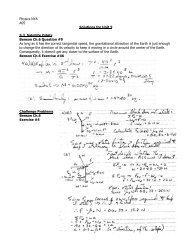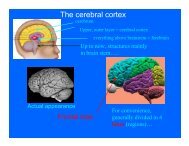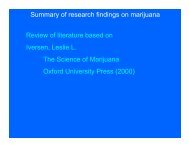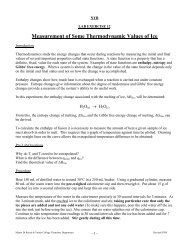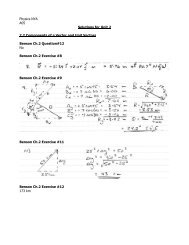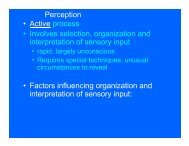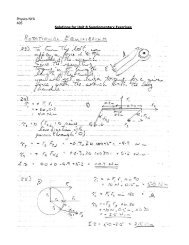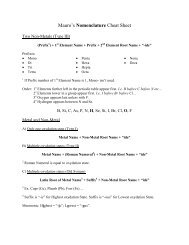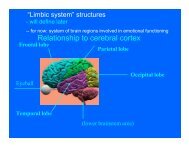Neurons & Neurotransmitters A typical neuron
Neurons & Neurotransmitters A typical neuron
Neurons & Neurotransmitters A typical neuron
Create successful ePaper yourself
Turn your PDF publications into a flip-book with our unique Google optimized e-Paper software.
<strong>Neurons</strong> & <strong>Neurotransmitters</strong><br />
<strong>Neurons</strong>: cells specialized for processing<br />
information<br />
A <strong>typical</strong> <strong>neuron</strong><br />
Dendrites<br />
INPUT END<br />
Signals<br />
received<br />
(neurotransmitters)<br />
Cell body<br />
Axon<br />
Axon<br />
branches<br />
&<br />
terminal<br />
buttons<br />
OUTPUT END<br />
(Signals<br />
transmittedneurotransmitters)
Some brief points about <strong>neuron</strong>s<br />
1) Functioning of <strong>neuron</strong>s involves electrical<br />
activity within “axon”<br />
Axon<br />
Under certain circumstances, a <strong>neuron</strong> will become active<br />
generate wave of activity similar to electrical current<br />
Neuron is “firing”<br />
(generating nerve<br />
impulse)
Other important point about <strong>neuron</strong>s:<br />
• they communicate with and influence each each<br />
other through release of specialized chemicals =<br />
neurotransmitters
How this enables one part of brain to influence another<br />
Locus<br />
coeruleus<br />
• Tiny structure, consists of ~ 12,000 <strong>neuron</strong>s<br />
• But they project to wide areas of brain lying above<br />
• Each <strong>neuron</strong> can influence thousands of other<br />
<strong>neuron</strong>s<br />
by releasing neurotransmitter, norepinephrine
• Norepinephrine has effect of sensitizing the <strong>neuron</strong>s<br />
(prepares them to become active)<br />
• e.g., <strong>Neurons</strong> in prefrontal cortex may be required to make<br />
decision- if sensitized, can react more quickly<br />
• Sequence of events may have begun with amygdala<br />
detecting a threat >> stimulates locus coeruleus >><br />
stimulates prefrontal cortex (and other areas)
How neurotransmitters influence <strong>neuron</strong>s<br />
1 2<br />
receptor<br />
[Figure 1 shows two adjacent <strong>neuron</strong>s.<br />
Although terminal buttons of <strong>neuron</strong> on left appears to be touching<br />
<strong>neuron</strong> on right, there is actually a small gap between them (=<br />
synapse; see Figure 2)<br />
<strong>Neurotransmitters</strong> (NTs) are being released from terminal buttons<br />
of <strong>neuron</strong> on left into synapse (= presynaptic <strong>neuron</strong>) (<br />
~ <strong>neuron</strong> sending messages)<br />
Neuron on other side of synapse = postsynaptic <strong>neuron</strong>. (~<br />
<strong>neuron</strong> that receives the messages) contains structures<br />
(receptors) which can be influenced by the NTs
• Receptors can have various features<br />
• Common feature = binding site<br />
• Neurotransmitter molecule<br />
can briefly attach (bind) to<br />
binding site<br />
• But only if one important<br />
condition met:<br />
“Shape” (structure) of<br />
binding site must match<br />
shape of<br />
neurotransmitter<br />
[simplified representation here,<br />
more realistic >>>
[NT has complex<br />
3–dimensional<br />
structure; binding site<br />
has to have<br />
corresponding 3-D<br />
structure to allow NT<br />
to attach]
• Over 50 different neurotransmitters used for<br />
communication within brain<br />
• Each has specific shape (molecular structure)
• Binding sites on receptors also have shapes<br />
• Match shape of one- and only one- type of<br />
neurotransmitter- I.e. are sensitive to only this<br />
neurotransmitter<br />
• e.g., some receptors are responsive only to<br />
GABA<br />
• major “inhibitory” NT in brain<br />
• Reduces activity in <strong>neuron</strong>s<br />
• E.g., plays major role in keeping amygdala<br />
from becoming overactive<br />
• GABA is the neurotransmitter<br />
predominantly used by PFC to inhibit<br />
activity in amygdala
• Other receptors are responsive only to the NT<br />
dopamine<br />
• Plays major role in brain’s reward<br />
(“pleasure”) system >>
The importance of binding sites on receptors<br />
By attaching to receptor binding sites<br />
N-Ts cause structures in walls of the<br />
axon to open (gates or “ion channels””)<br />
allows electrically charged particles (ions) to flow<br />
into <strong>neuron</strong> >> alters electrical activity in <strong>neuron</strong><br />
Positively charged particles stimulate <strong>neuron</strong><br />
(moved towards firing)<br />
Negatively charged particles inhibit it (prevent<br />
it from firing)<br />
[Neurotransmitter<br />
molecule attaching<br />
here is what causes<br />
ion channel to open]
look-ahead<br />
Why do psychoactive drugs have effects<br />
on psychological functioning?<br />
• [on how we feel, thinking, memory, etc.]<br />
• affect neurological functioning, usually at<br />
level of neurotransmitter systems<br />
• E.g., Simplest basis for drug effects >>>>>>
• A drug can have a chemical structure so<br />
similar to that of a NT that it attaches to<br />
binding sites for that NT<br />
• If the NT has effect of stimulating (exciting)<br />
<strong>neuron</strong>s in certain brain areas,<br />
• the drug will excite those <strong>neuron</strong>s and cause<br />
them to become active<br />
• The drug is “mimicking” the NT<br />
• [briefly discuss opiates ~ endorphins<br />
cannabis ~ endocannabinoids]






